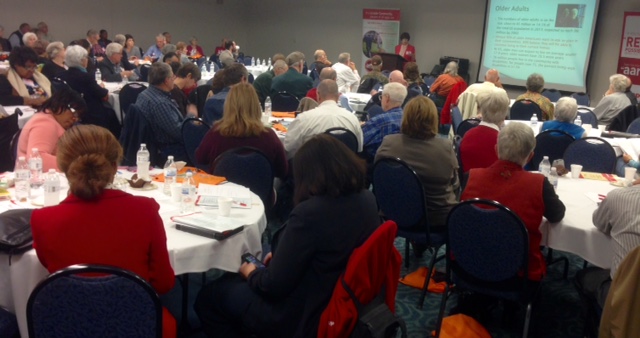AARP Hearing Center

They came by the dozens, some with walkers or wheelchairs, some by bus or taxi, all with transit horror stories.
A handicapped man from Lansing told a story about the time he found a ride to the emergency room at a local hospital in late afternoon but had no ride home when he was released at 2 a.m. because taxis aren’t equipped to deal with his wheelchair.
A woman from Eaton County shared how she spent hours on the phone last week trying to arrange transportation across county lines.
Another from Meridian Township talked about being transferred from a bus to a Spec-Tran van and back again just to get to an appointment that should have taken a fraction of the drive time.
A blind man from Clinton County reported that he can’t find a service that will take him from appointments to his door.
More than 160 people showed up at the AARP Michigan-hosted Capital Region Transportation Forum in East Lansing Thursday to talk to officials about how difficult it can be just to "get there."
Residents who are older or physically limited need or want to get to doctor appointments, grocery stores, churches, malls, restaurants and movies just like everyone else, they pointed out.
Officials on hand acknowledged that there are plenty of holes in the regional transportation system.
"Older adults need to have regional mobility. This is a rural and an urban problem," said Sue Pigg, executive director of the Tri-County Regional Planning Commission. “Everybody in the room is aware of the issues regarding transit. What we need now are action steps.”
East Lansing Mayor Nathan Triplett said the way these issues are addressed will speak volumes about the region's character and commitment to giving everyone opportunities for quality of life, regardless of age or physical ability.
"Transportation is one of the most important issues facing our city,” he said. “This is all about who we want to be as a region when we grow up.”
Other observations during the day-long forum at the East Lansing Hannah Community Center:
- By 2030, one in four drivers will be 65 or older and the number of drivers age 85 and older will be four to five times greater than today. Those who continue to drive will need training to keep up with the rules of the road. Those who don’t will need effective and affordable alternatives.
- People outlive their ability to drive by 7 to 10 years. If they don’t have viable options, this is a huge impact on their freedom and quality of life.
- There are 78 local units of government in Ingham, Easton and Clinton counties and finding ways to be transported across borders is a constant hassle because there is no integration.
- Availability of transportation alternatives is the second greatest challenge facing older adults, behind health care access.
- People waiting at bus stops are occasionally denied rides because the bus is full. Missed buses can mean long waits, sometimes in inclement weather.
- No weekend transportation service is offered in some areas.
- Transit lines that stop running in the early evening make it difficult to plan return trips.
- People who live in rural areas that are off the transit routes have limited or no transportation alternatives.
- Bus drivers, many of whom go the extra mile to accommodate individual rider needs, mitigate some of the problems with the system. But they can only do so much.
- Much of the long-term transportation planning centers on CATA’s developing rapid transit service, which isn’t going to be the answer for everyone.
- Easy, safe biking facilities are lacking in most communities.
"We need t rethink streets," said Andy Kilpatrick, transportation engineer for the City of Lansing. "They're not only used to move cars and trucks."
Several residents said they’re not interested in a transportation solution that raises taxes. Pigg of the Tri-County Planning Commission said a long-range plan will focus on “how do we better spread our resources across the region, across the boundaries.”
Karen Kafantaris, AARP Michigan Associate State Director for Livable Communities, said the intent of the forum was to put transportation users and officials in the same room to shed light on the issues.
“We wanted to give residents and public officials a forum to talk about transportation needs that aren’t being met,” she said. “Safe, efficient and affordable modes of transportation are essential to a community’s economic growth and make for happier, healthier residents of all ages.”































































